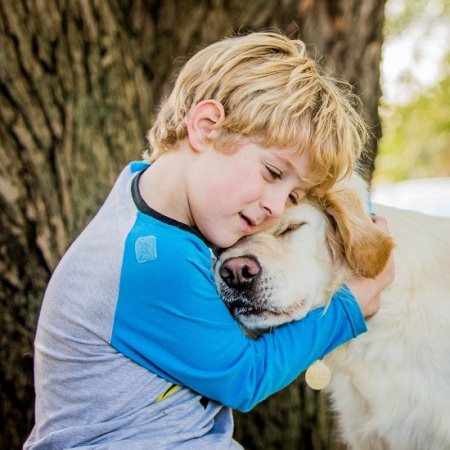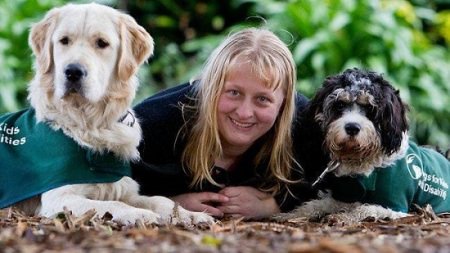The life-changing work of Dogs for Kids
Dogs for Kids is a Victorian-based organisation that raises and trains assistance dogs and therapy dogs to work with kids and teenagers with a range of different disabilities. Inform spoke with founder, Katie Hunter about the work the organisation does and the impact an assistance or therapy dog can have.
Dogs can be the difference
While we might think assistance dogs are only used by those with a vision impairment, assistance or therapy dogs can provide plenty of benefits to children with a range of disabilities.
“Assistance dogs help families, or help children, access the community. For children that are really struggling on a safety level, leaving home and accessing the community and doing day-to-day tasks, dogs can help them access the community safely,” Katie told Inform.
The dogs that Dogs for Kids trains can often be the difference between a child accessing the community or not.
“A lot of the children we work with for our assistance dog program are on the autism spectrum disorder. They’re generally lower functioning, so they may not be very verbal, they won’t be able to assess danger and risk.
“So we can pattern new behaviours and expose these children to different environments slowly and safely. Which builds a coping strategy in them. So some of our families a year or two after receiving a dog, can actually go to the supermarket without the dog. The child has learnt to hold a hand or walk within two metres of the parents because of that repeated exposure with a dog by their side supporting them. We’ve lowered their anxiety and stress levels in those environments so that they can cope.
“Some of our dogs improve speech and communication. So we’ve worked with families that when we’ve placed the dog in there, they’ve had first words, they’ve had engagement. It just really depends on the child and every child is different and every dog is different.”

The dogs trained by Dogs for Kids can have a significant impact on children with disabilities. Image: Supplied.
Help in the community and at home
Assistance dogs, Katie explains, can help children with balance and movement, while also keep those prone to ‘bolting’ or ‘running’ safe with a belt and tether system.
“If the child goes to run, the parent commands the dog to lay down and anchor. So we can lower anxiety and stress [and] make getting out of your house a bit safer.
“It’s very much about safety, inclusion, and getting out into the community.”
In many cases, Katie says having a dog in the household can also help to lower anxiety.
“That has an overall effect on a family,” Katie said, “Not just on the children.”
Dogs for Kids train both assistance and therapy dogs. Assistance dogs have greater exposure to the public, helping children to access the community. While therapy dogs have less exposure to the community and spend more time working in the home.
“There are a lot of families that don’t need that help in the community, they need to help at home. So they might have a child that actually holds themselves together, out and about but explodes and combusts at home. And a dog at home can lay on top of them provide some deep pressure, lick their face, fetch a ball, do tricks and try and engage them and lower their anxiety in that home environment as well.
“Plus, some of our dogs end up working in schools. So instead of working for one, they’ll rotate through classrooms and help a multitude of different kids in a school setting.”

Katie Hunter, the founder of Dogs for Kids, see the impact an assistance or therapy dog can have in the life of a child. Image: Supplied
Training Dogs for Kids
It was while working as a guide dog trainer that Katie had the idea for Dogs for Kids. Katie saw the dogs who didn’t make the grade to be guide dogs still have a positive impact on families, and particularly children with autism.
“I saw the benefit that those dogs had. But kind of got to the point where I was like, wow, what could a dog do if we actually trained it to do that, to do this job rather than it just not having the skill set for another type of assistance work.”
Dogs for Kids launched in 2012 and trains about 10 assistance and therapy dogs every year. It’s a long process, often taking up to two years to get a dog ready to join a family. Katie says that in the first 12 to 18 months, the dogs spend time being socialised and exposed to lots of different sights and sounds.
“Hearing different noises, seeing different sights is a really important part of their first 12 to 18 months as they’re growing and developing. So they go out with volunteers for the first 12 to 18 months and get socialised to a variety of environments… they’re getting used to everything so that they can make an informed decision whether they want to work or not.
“Once they’re more mature at about 12 to 18 months old… when they’re ready, they’ll come into training. That formal training is when they’ll live with a volunteer. But our trainer will pick them up and they essentially go to school Monday to Friday.
“And that process takes about six months, as well. So it’s generally between 80 to 100 intense training hours that they’re receiving in a four to six month period.”
Dogs for Kids life-changing
Caring for and training a dog is an expensive process. It costs up to $50,000 to get a dog ready to work with a child. But Katie says the investment is worth is because the impact a trained assistance or therapy dog can have in a child’s life is significant. Everything from helping a child sleep through the night or transition into their own bed to helping them make friends.
“They can help kids make friends. So if you’ve got a dog, when you take that dog for a walk, people automatically smile at you and say hello. It’s a little bit like you’ve joined a club that you didn’t even know you joined. It just puts a friendly face to something so I think that’s hugely powerful for a lot of kids as well.”
It’s seeing those changes in the lives of children that keeps Katie doing this work.
“I’m addicted to it, I can tell you that. I love working with kids.”
“It’s a pretty powerful job when you get to see a family’s life change. [When] you get to see them access the community more or a child sleeps better or develops speech or starts to try new foods, makes new friends. It’s a pretty special thing to be a part of.”
“But every family that receives a dog tends to have some sort of benefit like that. Some of it will be an overnight change. And some of it will be months down the track that they’re seeing different things change for them. But it’s quite common for us to hear first words. To get reports of a child sleeping through the night for the first time after waiting seven or eight years. And so they are what keeps you going.”
Ready to read more? Try these Inform links:
Rona routine: living with ADHD during COVID-19
How working in disability advocacy helped me feel disability pride
